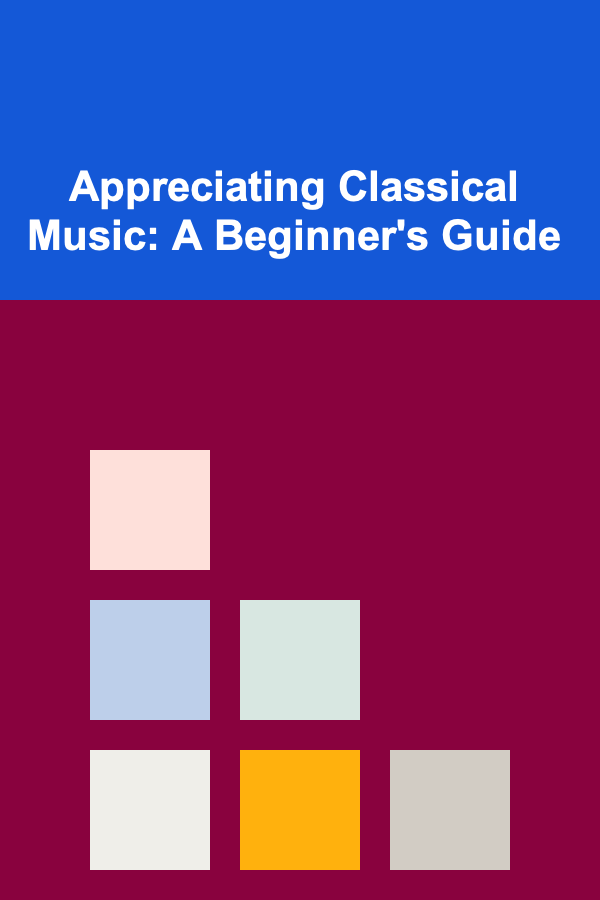
Appreciating Classical Music: A Beginner's Guide
ebook include PDF & Audio bundle (Micro Guide)
$12.99$6.99
Limited Time Offer! Order within the next:

Classical music, often perceived as complex and intimidating, is actually a rich tapestry of human expression, historical context, and artistic innovation. This guide aims to demystify classical music for beginners, providing a roadmap to understanding and appreciating its beauty, complexity, and lasting impact. It's not about becoming a musicologist overnight, but rather about opening your ears and mind to a world of sonic possibilities.
Understanding the Fundamentals
Before diving into specific composers or pieces, it's helpful to grasp some basic musical concepts. Don't worry, you don't need to read music; this is about listening and understanding what you hear.
Elements of Music
- Melody: The tune, the main sequence of notes that you can hum or sing. Think of it as the musical sentence.
- Harmony: The chords that accompany the melody, providing depth and richness. Harmony is what makes the melody sound 'fuller' and adds emotional color.
- Rhythm: The pattern of beats and accents that give music its structure and pulse. Think of it as the heartbeat of the music.
- Tempo: The speed of the music. Common terms include Allegro (fast), Andante (moderate), and Adagio (slow).
- Dynamics: The loudness or softness of the music. Terms like forte (loud) and piano (soft) are frequently used. Changes in dynamics can create drama and emotional impact.
- Timbre: The unique sound quality of an instrument or voice. It's what makes a violin sound different from a trumpet, even when playing the same note. Timbre adds color and texture to the music.
- Texture: How the different musical lines are combined. Common textures include:
- Monophony: A single melodic line (e.g., someone singing alone).
- Homophony: A melody with chordal accompaniment (e.g., a singer with a guitar).
- Polyphony: Multiple independent melodic lines interwoven (e.g., a round like "Row, Row, Row Your Boat").
- Form: The overall structure of a piece of music. This could be a simple A-B-A form (where A is one section, B is a contrasting section, and A returns), or a more complex form like sonata form (discussed later).
Orchestral Instruments
The orchestra is the primary ensemble for much of classical music. Familiarizing yourself with the different instrument families is crucial.
- Strings: Violin, viola, cello, double bass. These instruments produce sound by vibrating strings, typically with a bow. They form the core of the orchestra, often carrying the melody.
- Woodwinds: Flute, clarinet, oboe, bassoon. These instruments produce sound by blowing air into them. Each has a distinct timbre and range, contributing to the overall orchestral color.
- Brass: Trumpet, horn (French horn), trombone, tuba. These instruments produce sound by buzzing the lips into a mouthpiece. They are often used for powerful and majestic passages.
- Percussion: Timpani, snare drum, cymbals, triangle, xylophone. These instruments produce sound by being struck, shaken, or scraped. They provide rhythmic drive and add color to the orchestra.
- Keyboard: Piano, harpsichord, organ. While not always part of the core orchestra, keyboard instruments are frequently featured as soloists or as part of the ensemble.
Listening to examples of each instrument family playing solo can greatly enhance your ability to identify them in orchestral music. Search for "orchestral instrument identification" or "orchestral instrument solos" on YouTube or your preferred music streaming service.
Exploring Different Eras
Classical music spans several centuries, and each era has its own distinct characteristics. Understanding the historical context can significantly deepen your appreciation.
The Baroque Period (c. 1600-1750)
The Baroque era was characterized by ornamentation, grandeur, and a focus on counterpoint (interweaving melodic lines). Think of it as ornate architecture translated into sound.
- Key Composers: Johann Sebastian Bach, George Frideric Handel, Antonio Vivaldi.
- Characteristics:
- Elaborate melodies and ornamentation.
- Use of counterpoint (multiple independent melodic lines).
- Terraced dynamics (sudden shifts between loud and soft).
- Use of the basso continuo (a continuous bass line, usually played by a cello or bassoon with a keyboard instrument improvising chords above it).
- Recommended Listening:
- Bach: Brandenburg Concertos, Goldberg Variations, Toccata and Fugue in D Minor
- Handel: Messiah (especially the "Hallelujah" chorus), Water Music, Music for the Royal Fireworks
- Vivaldi: The Four Seasons, Gloria
The Classical Period (c. 1750-1820)
The Classical era emphasized clarity, balance, and elegance. Think of it as clean lines and symmetrical structures.
- Key Composers: Wolfgang Amadeus Mozart, Joseph Haydn, Ludwig van Beethoven (early period).
- Characteristics:
- Clear and balanced melodies.
- Emphasis on homophony (melody with chordal accompaniment).
- Use of the sonata form (a common structure for the first movement of symphonies, concertos, and sonatas). Sonata form typically consists of:
- Exposition: Presentation of the main themes.
- Development: Exploration and transformation of the themes.
- Recapitulation: Restatement of the themes in the original key.
- Development of the orchestra.
- Recommended Listening:
- Mozart: Symphony No. 40, Piano Concerto No. 21, The Marriage of Figaro (opera)
- Haydn: Symphony No. 94 ("Surprise"), String Quartet Op. 76 No. 3 ("Emperor")
- Beethoven: Symphony No. 1, Piano Sonata No. 14 ("Moonlight Sonata") (early period)
The Romantic Period (c. 1820-1900)
The Romantic era was marked by emotional intensity, individualism, and dramatic expression. Think of it as vivid colors and passionate storytelling.
- Key Composers: Ludwig van Beethoven (later period), Franz Schubert, Robert Schumann, Clara Schumann, Frédéric Chopin, Johannes Brahms, Pyotr Ilyich Tchaikovsky, Gustav Mahler.
- Characteristics:
- Emphasis on emotion and expression.
- Expanded use of dynamics and instrumentation.
- More complex harmonies and melodies.
- Use of programmatic music (music that tells a story or evokes a specific image).
- Recommended Listening:
- Beethoven: Symphony No. 5, Symphony No. 9, Piano Sonata No. 29 ("Hammerklavier") (later period)
- Schubert: Winterreise (song cycle), Symphony No. 8 ("Unfinished")
- Chopin: Nocturnes, Ballades, Polonaises
- Tchaikovsky: Swan Lake (ballet), Symphony No. 6 ("Pathétique")
- Brahms: Symphony No. 4, Violin Concerto
- Mahler: Symphony No. 5, Kindertotenlieder (song cycle)
The 20th and 21st Centuries (c. 1900-Present)
The 20th and 21st centuries saw a wide range of musical styles, from atonality and serialism to minimalism and neo-Romanticism. Think of it as a period of experimentation and exploration.
- Key Composers: Igor Stravinsky, Arnold Schoenberg, Béla Bartók, Dmitri Shostakovich, Philip Glass, Steve Reich, John Adams.
- Characteristics:
- Experimentation with new sounds and techniques.
- Breaking away from traditional harmonic and melodic structures.
- Use of atonality (music without a tonal center).
- Use of serialism (music based on a predetermined series of notes).
- Rise of minimalism (music with repetitive patterns and gradual changes).
- Recommended Listening:
- Stravinsky: The Rite of Spring, Petrushka
- Schoenberg: Pierrot Lunaire, Verklarte Nacht
- Bartók: Concerto for Orchestra, Music for Strings, Percussion and Celesta
- Shostakovich: Symphony No. 5, String Quartet No. 8
- Glass: Einstein on the Beach (opera), Koyaanisqatsi (film score)
- Reich: Music for 18 Musicians, Tehillim
- Adams: Nixon in China (opera), Short Ride in a Fast Machine
Genre Exploration
Classical music encompasses various genres, each with its own characteristics. Here's a brief overview:
- Symphony: A large-scale orchestral work, typically in four movements. Each movement often has a distinct tempo and character.
- Concerto: A work for a solo instrument (e.g., piano, violin) and orchestra. It showcases the virtuosity of the soloist.
- String Quartet: A work for four string instruments (two violins, a viola, and a cello). It's like a conversation between four distinct voices.
- Sonata: A work for a solo instrument (e.g., piano) or a solo instrument with piano accompaniment. It often follows the sonata form structure.
- Opera: A dramatic work in which all or most of the text is sung. It combines music, drama, and visual spectacle.
- Chamber Music: Music for a small ensemble (e.g., a string quartet, a piano trio). It's typically performed in a more intimate setting than orchestral music.
- Ballet: A theatrical dance form that tells a story through movement and music.
- Choral Music: Music for a choir. It can range from simple hymns to large-scale oratorios.
Developing Your Listening Skills
Appreciating classical music is an active process. Here are some tips to improve your listening skills:
- Start Small: Don't try to listen to an entire opera or symphony at once. Begin with shorter pieces or individual movements.
- Listen Actively: Pay attention to the melody, harmony, rhythm, dynamics, and timbre. Try to identify the different instruments and sections of the orchestra.
- Read the Program Notes: Concert programs often provide valuable information about the composer, the piece, and its historical context.
- Listen Repeatedly: The more you listen to a piece, the more you'll notice and appreciate its nuances.
- Follow the Score (Optional): If you're musically inclined, following the score while listening can deepen your understanding of the music. Scores are often available online for free.
- Attend Live Performances: Experiencing classical music live is a transformative experience. The energy of the performers and the acoustics of the concert hall can enhance your appreciation.
- Explore Different Interpretations: Different conductors and performers can bring their own unique perspectives to a piece of music. Listening to multiple recordings of the same work can be illuminating.
- Don't Be Afraid to Experiment: Try listening to different composers, genres, and eras. You may be surprised by what you discover.
- Consider Listening With Headphones: Good quality headphones can help you hear the subtle details in the music.
- Use Streaming Services: Services like Spotify, Apple Music, and YouTube Music offer vast catalogs of classical music. Many also have curated playlists and recommendations to help you discover new music.
- Read About Classical Music: Books, articles, and websites can provide valuable insights into the history, theory, and appreciation of classical music.
Practical Exercises and Examples
Let's put these concepts into practice with some listening exercises.
Exercise 1: Identifying Instruments
Listen to a recording of Benjamin Britten's "The Young Person's Guide to the Orchestra." This piece is specifically designed to introduce the different instruments of the orchestra. Pay attention to the individual sections and try to identify each instrument as it is featured.
Exercise 2: Analyzing Form
Listen to the first movement of Mozart's Symphony No. 40. Try to identify the exposition, development, and recapitulation sections of the sonata form. Pay attention to how the main themes are presented and transformed throughout the movement.
Hint: The exposition typically presents two contrasting themes. The development explores these themes in new ways, often using fragmentation and modulation. The recapitulation restates the themes in the original key, providing a sense of resolution.
Exercise 3: Comparing Interpretations
Listen to two different recordings of Beethoven's Symphony No. 5 (e.g., one conducted by Carlos Kleiber and another by Leonard Bernstein). Pay attention to how the conductors interpret the tempo, dynamics, and phrasing. What differences do you notice? Which interpretation do you prefer, and why?
Exercise 4: Exploring Emotion
Listen to Chopin's Nocturne in E-flat Major, Op. 9 No. 2. What emotions does the music evoke? How does Chopin use melody, harmony, and dynamics to create this emotional effect?
Think about the overall mood, the use of dissonance and resolution, and the subtle changes in tempo and volume.
Common Misconceptions
There are several common misconceptions about classical music that can deter beginners:
- "It's boring." Classical music offers a wide range of styles and emotions. You just need to find what resonates with you.
- "It's too complicated." While some pieces are complex, many are surprisingly accessible. Start with simpler works and gradually explore more challenging repertoire.
- "You need to be a music expert to appreciate it." Not at all! All you need is an open mind and a willingness to listen.
- "It's only for old people." Classical music transcends generations. Its timeless beauty appeals to people of all ages.
- "You have to dress up to go to a concert." While some concerts may have a more formal dress code, many are quite casual. Check the venue's website for dress code information.
Resources for Further Exploration
Here are some resources to help you continue your journey into the world of classical music:
- Websites:
- AllMusic: Comprehensive database of classical music recordings and information.
- Classic FM: Radio station and website with news, articles, and playlists.
- WQXR: New York City's classical music radio station, with a website offering streams, articles, and podcasts.
- IMSLP (Petrucci Music Library): A vast library of free public domain sheet music.
- Books:
- The Rest Is Noise: Listening to the Twentieth Century by Alex Ross
- Classical Music: The Essential Listening Companion by Alexander Morin
- The NPR Listener's Encyclopedia of Classical Music by Ted Libbey
- Streaming Services:
- Spotify
- Apple Music
- YouTube Music
- Idagio (Specifically designed for classical music)
- Podcasts:
- The Classical Music Discoveries Podcast
- Classical Breakdown (WQXR)
- Sticky Notes: The Classical Music Podcast
Conclusion
Appreciating classical music is a journey, not a destination. There will be times when you're overwhelmed or confused, but don't give up. The rewards of discovering this vast and beautiful world are immeasurable. Be patient, be curious, and most importantly, be open to the power of music to move you, inspire you, and connect you to the human experience. Happy listening!

How to Create a Checklist for Managing Website Access Control
Read More
How to Create Engaging Pet Content to Attract Customers
Read More
How to Use Deep Learning for Building Profitable Digital Products
Read More
The Art of Product Management: Strategies for Leading Cross-Functional Teams
Read More
How to Build Quantum-Resistant Encryption
Read More
Understanding Blockchain for Enterprise Solutions
Read MoreOther Products

How to Create a Checklist for Managing Website Access Control
Read More
How to Create Engaging Pet Content to Attract Customers
Read More
How to Use Deep Learning for Building Profitable Digital Products
Read More
The Art of Product Management: Strategies for Leading Cross-Functional Teams
Read More
How to Build Quantum-Resistant Encryption
Read More